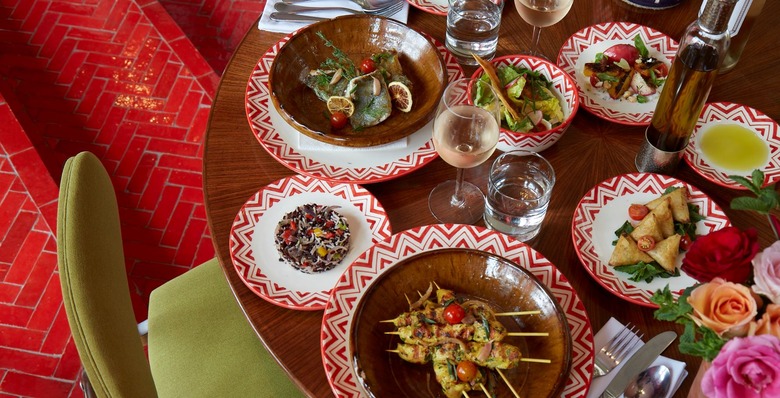Marrakesh's El Fenn: A Stylish Riad That's Also One Of The City's Best Places To Eat
It had been raining in intermittent torrents the night I checked into El Fenn, a riad — a traditional Moroccan house characterized by the presence of a central, fountained courtyard — located an almost literal stone's throw away from the Bab Ksour neighborhood in the Marrakesh medina (old town). My feet were damp, and my stomach was ready for the comfort of Moroccan food. A lady swaddled in a lipstick-red cape led me from the fireplace-adorned reception area, beneath a canopy of citrus trees in the courtyard, past a grid of arrestingly beautiful images by German photographer Hans Silvester set against a scarlet wall, and through a windowed door into the ethno-chic dining room of The El Fenn Cocktail Bar & Restaurant bespotted with the tiny fires of candlelight and the murmurs of well dressed guests.
El Fenn means "fine arts" in Arabic, and it is palpable that the expression of creativity is precisely what this establishment espouses. The riad is well known to be a favorite of the fashionable and creative set that visits Marrakesh. Technically, however, El Fenn is more a collection of riads than a single riad given its size and the multiplicity of colorful courtyards it boasts. Yet the first sense of the place is still one of singularity and intimacy, the reason so many visitors to the Red City choose riad lodgings over standard hotels.
The dining area shares a space with El Fenn's boutique, which stocks a variegated selection of local and international designs. My dinner date was already seated at a round marble-topped table by the gleaming bar. I apologized for my tardy arrival as a waiter clad in head-to-toe white, as though reading my ravenous mind, handed us each a newspaper style menu just as I took my seat. El Fenn's head chef, Ahmad Elhardoum, has devised as catholic a menu as the design influences of the riad's space. From an array of six intriguing appetizers including escargot poached in licorice-spiked broth and a millefeuille of eggplant, tomato and chèvre, we both decided on the grilled scallops. I was pleased to to hear that the fish is sourced from nearby coastal towns of Dakhla and Agadir; the kitchen at El Fenn prides itself on being a green one, serving organic fruit and vegetables from the Ourika Valley and sourcing its meats from butchers in the Marrakesh medina.
The wine list is extensive for the restaurant's quaint size: whites, red, gris, rosés from Morocco as from France, and a small who's who of Champagnes. I ordered a whiskey sour from the equally impressive cocktail offerings and it was just what the doctor ordered for shaking off the oppresively wet day. The scallops arrived, simply plated on a mousseline of red lentil, and simply delicious. We'd both chosen the tagine of rabbit as our main dish, tagine being the typical Maghrebi dish of meat, fish or vegetables, named after the covered clay pot in which it is prepared. I have partaken in my fair share of tagine over several trips to Morocco (my favorite being the lamb and prune tagine served at Nord Pinus in Tangier), but I'd never tasted a tagine of rabbit and so I was particularly eager to try this rarity. Our waiter uncrowned the clay pot to reveal a sizzling stew of rabbit leg with saffron, confit lemon and meslada olives. The aroma was intoxicating, the flavor distinct: layered and light all at once. I was already thinking about ordering the rabbit tagine again the next night after the first supple bite.
And therein lies the draw of El Fenn: the elegant riad, voted 2014's "Best Dressed Hotel" in the Mr. and Mrs. Smith Hotel Awards, serves such satisfying food that choosing not to slog through the puddled alleyways of the medina on a rainy weekend and eat all of one's meals at the hotel is a pleasure rather than punishment. Yes, a visit to Marrakesh is indeed all about getting a little lost in the mêlée of the medina, sipping fresh juice in the concrete glade of Jemaa El Fna Square and paying far too much for a pair of babouches in the souks. But, should one wish to spend an entire sojourn in the city within the walls of El Fenn, one would be well rewarded; the hotel is, itself, like the medina that surrounds it: a celebration of vivacious color and home to one of the most celebrated restaurants in the city.
I awoke the next morning in my sprawling, red room thinking of the rabbit tagine I would undoubtedly have for dinner again that night. I'd have to get through the hurdle of breakfast first. Poor me, resigned to the fate of spooning hot shakshouka down my throat while overlooking the snow-sprinkled peaks of the Atlas Mountains from the hotel's rooftop terrace. Suddenly, dinner could wait: the shakshouka (a dish of tomatoes, onions, peppers and eggs) was so tasty my dinner dreams were replaced with a longing for the next morning's breakfast.
So, did I have my rabbit tagine for dinner again? Once night had fallen, I couldn't bring myself to repeat the meal at the expense to trying something else from the creative menu. Thumbing the menu once more by candlelight, I chose, instead, the quail tagine. Laced with honey, cinnamon and Ras el Hanout, quail Mrouzia was quintessential Morocco in an earthenware pot. I made the right choice, not just with the quail, but in my decision to stay in at El Fenn.
This hotel stay was provided at no cost to the writer. Meals were paid for by the writer.
